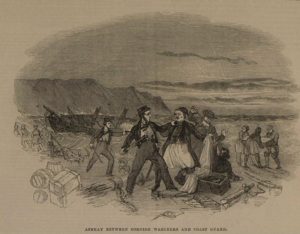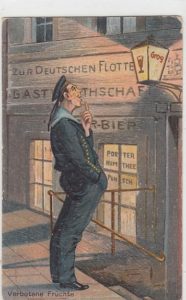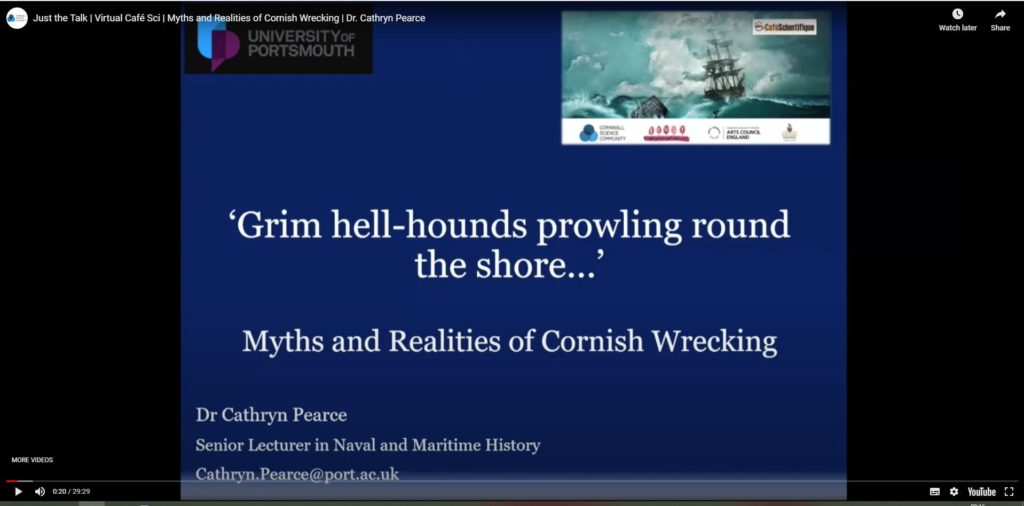This page showcases some of the research of our team at Port Towns and Urban Cultures, and guest lectures from the University of Portsmouth History Seminars. Scroll down to find videos and video links and listen to our collection of Port Town scholarship!
Dr Mathias Seiter, ‘Police, Pubs, and Prostitution: Navigating the Social and Spatial Boundaries of Naval Sailortowns in Imperial Germany, c. 1871-1918’. University of Portsmouth History Webinar, delivered 17 June 2020.
Abstract:
Naval port towns were regarded as potent symbols of the strength of empire. Yet beneath this image of imperial power, contemporaries were concerned about the vice associated with infamous sailortown areas. Their reputation as spaces of heavy drinking, prostitution, and raucous behaviour led to attempts by civic and naval authorities to closely police sailortown as well as its shadow economy.
By examining imperial Germany’s two main naval ports, Kiel on the Baltic Sea and Wilhelmshaven on the North Sea coast, this paper will explore how sailors as well as the civilians who lived and worked in sailortown navigated the social and spatial restrictions which shaped life in these urban-maritime liminal spaces. While the police tried to impose law and order, naval sailors and civilians challenged the enforced social, moral, and spatial boundaries of sailortown. At night the fighting and drinking of naval ratings could easily spill out into respectable areas of the towns. Women who were accused of being prostitutes sought to evade the authorities by exploiting local spatial and administrative peculiarities which allowed them to move around or to contest allegations of immorality. This paper will highlight the agency of ordinary people in their interactions with authorities and explore how spatial-administrative structures shape these interactions.
Dr Me lanie Bassett, ‘East’ meets ‘West’: British and Antipodean reactions to Japanese naval visits in the early 20th century. University of Portsmouth History Webinar, delivered 1 July 2020.
lanie Bassett, ‘East’ meets ‘West’: British and Antipodean reactions to Japanese naval visits in the early 20th century. University of Portsmouth History Webinar, delivered 1 July 2020.
Abstract:
Dr Melanie Bassett, Faculty Research Fellow for Port Towns and Urban Cultures, University of Portsmouth, will explore the relationship that the British Empire’s citizens had with one of their most controversial allies of the pre-First World War period – the Japanese.
The 1902 Anglo-Japanese Alliance marked the end of Britain’s ‘splendid isolation’. However, such an alliance presented some interesting complications to the received Edwardian racial hierarchy and challenged the idea of British military supremacy. The alliance with Japan allowed the Royal Navy to concentrate their fleets in European waters. However, this strategy caused resentment due to the underlying fear of ‘Yellow Peril’ and the increasing influence of the Imperial Japanese Navy in the Pacific – a direct threat to the security of the British Dominions, Australia and New Zealand.
Find out how the Japanese fleet was received in Portsmouth (UK) and ports in Australia, and how both the hosts and their Nippon guests negotiated the cultural and racial divide amid the background of a contentious alliance.
 Dr Cathryn Pearce, ‘”Grim hell-hounds prowling around the shore …” Myths and Realities of Cornish Wrecking.’ Cornwall Science Community lecture at Café Scientifique, delivered on 15 July 2020.
Dr Cathryn Pearce, ‘”Grim hell-hounds prowling around the shore …” Myths and Realities of Cornish Wrecking.’ Cornwall Science Community lecture at Café Scientifique, delivered on 15 July 2020.
Abstract:
‘…the grim hell-hounds prowling round the shore…’ – so poet and seaman William Falconer described the frightful crowds of wreckers plundered ships unfortunate to run aground on England’s coast in the eighteenth century. The malevolent reputation of wreckers was popularised and sustained through similar descriptions and rhetoric in Victorian novels, short stories and opera, and by sensationalised stories printed in local and national newspapers. Wreckers, too, are found in legends throughout Britain and Ireland. However, the stereotype became solely applied to Cornwall. But who were they, really?
In this presentation, Dr Cathryn Pearce, Senior Lecturer in Naval and Maritime History at the University of Portsmouth, will share her journey uncovering the reality behind the notorious wrecker. She may even mention that most notorious of charges, deliberate wrecking!’ Watch the full lecture on YouTube here: https://www.youtube.com/embed/gdHcOP_rxkY
Jayne Friend (University of Portsmouth PhD candidate), “Unity, identity and localised naval theatre: Royal Navy destroyer flag-flying visits and civic celebrations in interwar Britain.” University of Portsmouth History Webinar, delivered 13 January 2021.
Abstract:
This paper explores the symbolic role that Royal Navy destroyers fulfilled in regional civic celebrations and flag-flying visits around the British coastline, which aimed to unite notions of Britishness and nationhood. Following the First World War, increasingly divergent notions of identity and nationhood had developed in Britain, provoked by the strains of war and the management of an extensive and increasingly unsettled Empire. As the prominent means of protection in home waters, destroyers represented the security of the coast and preservation of a British way of life, but also provided links to the rest of the Empire through their imperial visits and work in maintaining sea trade routes. Destroyers visited numerous regional and coastal locations performing fake battles and light displays, taking part in pageants, sporting events and commemorations and the opening of municipal buildings. These were highly ceremonial and interactive events reflecting both the intrusion of naval culture into civilian society and the impact of civic pride and regional identities on the role of the destroyer as ambassadors of the Navy. Consequently, these spectacles determined that the destroyer symbolised a tangible link between local communities, the nation and the wider Empire.
Dr Katherine Parker (Research Officer, Barry Lawrence Ruderman Antique Maps Inc.; Teaching Associate, Queen Mary University of London), ‘Charting and Printing the Straits: The maps of the Narbrough expedition (1669-1671)’. University of Portsmouth History Webinar, delivered 10 February 2021.
Abstract:
In the long eighteenth-century, exploration changed pointedly in its cultural meanings from an activity linked to corporate or state reconnaissance to a supposedly universally-beneficial search for knowledge, as Adriana Craciun and Marie Noelle Bourguet have explained. What did not change, although the objects themselves shifted significantly in execution, appearance, and content, was the importance of maps and charts to the exploratory process. This paper will trace the use of cartography in the Narbrough expedition to Valdivia, Chile through the Straights of Magellan in 1669-1671. Narbrough provides an important case study in mapping the Pacific and also marks an important point in the history of Pacific exploration in that it was the first Admiralty-sponsored voyage to the South Seas. From their role in the planning of the expedition, to the use of map and charts while sailing, to the production of new charts while on the expedition and after, this paper will seek to interrogate the role of cartography in a significant, if understudied, voyage. While Narbrough may not be a household name today, he was an important source for later navigators including George Anson and James Cook. His use, production, and display of charts also allows a glimpse into the politicization of exploration, with changes in cartographic objects impacted by changes in patronage, as well as domestic and international affairs.
Dr Scott Daly (University of Southampton), ‘”On the water, our hostility was in full vigour”: Gibraltar and the Royal Navy, 1779-1830’‘. University of Portsmouth History Webinar, delivered 11 May 2022.
Abstract:
Dr Cathryn Pearce (University of Portsmouth), ‘’Bandied about for a place of refuge’: Extreme Weather, Coastal Shipping and the Loss of Lord Nelson, Liverpool 1840.’ University of Portsmouth History Webinar, delivered 19 October 2022.
Abstract:
In November 1840, the coastal brig Lord Nelson ran aground in Liverpool Bay. The crew spent the night tied to the one remaining mast, washed over by a freezing sea, until rescued the following morning. Although this is was one minor shipwreck case among many that took place in Victorian Liverpool’s watery jurisdiction, a microhistorical examination of their experiences illuminates a coastal world few historians have examined. It will show how the crew was depicted by the press and their suffering instrumentalized, reactivating debates about civic and social responsibility for seafarers and the shipwrecked in a port dominated by shipping interests.











